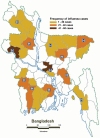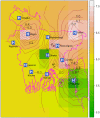Influenza in outpatient ILI case-patients in national hospital-based surveillance, Bangladesh, 2007-2008
- PMID: 20041114
- PMCID: PMC2795194
- DOI: 10.1371/journal.pone.0008452
Influenza in outpatient ILI case-patients in national hospital-based surveillance, Bangladesh, 2007-2008
Abstract
Background: Recent population-based estimates in a Dhaka low-income community suggest that influenza was prevalent among children. To explore the epidemiology and seasonality of influenza throughout the country and among all age groups, we established nationally representative hospital-based surveillance necessary to guide influenza prevention and control efforts.
Methodology/principal findings: We conducted influenza-like illness and severe acute respiratory illness sentinel surveillance in 12 hospitals across Bangladesh during May 2007-December 2008. We collected specimens from 3,699 patients, 385 (10%) which were influenza positive by real time RT-PCR. Among the sample-positive patients, 192 (51%) were type A and 188 (49%) were type B. Hemagglutinin subtyping of type A viruses detected 137 (71%) A/H1 and 55 (29%) A/H3, but no A/H5 or other novel influenza strains. The frequency of influenza cases was highest among children aged under 5 years (44%), while the proportions of laboratory confirmed cases was highest among participants aged 11-15 (18%). We applied kriging, a geo-statistical technique, to explore the spatial and temporal spread of influenza and found that, during 2008, influenza was first identified in large port cities and then gradually spread to other parts of the country. We identified a distinct influenza peak during the rainy season (May-September).
Conclusions/significance: Our surveillance data confirms that influenza is prevalent throughout Bangladesh, affecting a wide range of ages and causing considerable morbidity and hospital care. A unimodal influenza seasonality may allow Bangladesh to time annual influenza prevention messages and vaccination campaigns to reduce the national influenza burden. To scale-up such national interventions, we need to quantify the national rates of influenza and the economic burden associated with this disease through further studies.
Conflict of interest statement
Figures






References
-
- WHO. Influenza. Fact sheet N°211. 2003. Available: http://www.who.int/mediacentre/factsheets/fs211/en/
-
- CDC. Influenza: The Disease. Flu Basics. 2008. Available: http://www.cdc.gov/flu/about/disease/index.htm.
-
- Molinari NA, Ortega-Sanchez IR, Messonnier ML, Thompson WW, Wortley PM, et al. The annual impact of seasonal influenza in the US: measuring disease burden and costs. Vaccine. 2007;25:5086–96. - PubMed
Publication types
MeSH terms
Grants and funding
LinkOut - more resources
Full Text Sources
Medical

